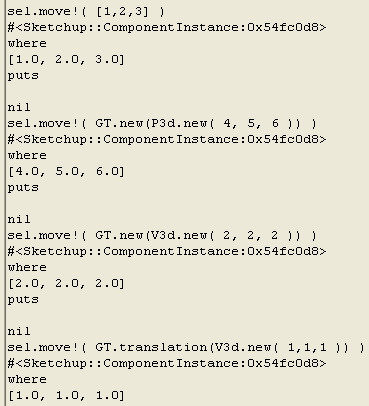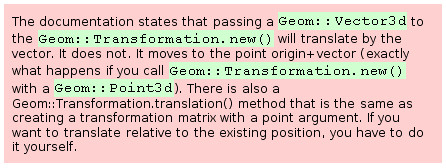Geom::Transformation.new( Vector3d )
-
Yes, I see what you mean ...
inst.transformation = Geom::Transformation.new([10,0,0])
moves it to 10,0,0
inst.transform!(Geom::Transformation.new(Geom::Point3d.new(10,0,0)))
moves it by [10,0,0] from its current location - if that's [10,0,0] it moves to [20,0,0] as if had been passed a vector and NOT a point ??? the same as .translation does...
the same as .translation does...So to 'transform!'
instto a fixed point you need
new_point=Geom::Point3d.new(1,0,0) inst.transformation = Geom::Transformation.new(new_point)BUT 'move!' won't work as it takes a transformation as its argument and making a .new(point) transformation is no different from a .new(vector) transformation ?


In fact .new() can be several types of transformation not just 'point' as I said:
Geom::Transformation.newwith no arguments creates a new identify Transformation.Geom::Transformation.new(pt)creates a Transformation that translates the origin to pt. [This seems to be faulty as it's the transformation origin NOT the ORIGIN ??? i.e. NOT an 'Absolute' move but a 'Relative' one - Making it equivalent to using (vec) !!!]Geom::Transformation.new(vec)creates a Transformation that translates by vector vec.Geom::Transformation.new(transform)creates a Transformation that is a copy of another Transformation. This is equivalent to transform.clone.Geom::Transformation.new(array)creates a Transformation from a 16 element Array.Geom::Transformation.new(scale)creates a Transformation that does uniform scaling.
Geom::Transformation.new(origin, zaxis)creates a Transformation where origin is the new origin, and zaxis is the z axis. The x and y axes are determined using an arbitrary axis rule.Geom::Transformation.new(pt, xaxis, yaxis)creates a Transformation given a new origin, x axis and y axis.Geom::Transformation.new(pt, axis, angle)creates a Transformation that rotates by angle (given in radians) about a line defined by pt and axis.[ruby:18i055ij]Geom::Transformation.new(xaxis, yaxis, zaxis, origin)[/ruby:18i055ij] creates a Transformation from 3 axes and an origin.
Confused, you will be...

-
.move!is good when you want to move without affecting the undo-stack. -
@thomthom said:
.move!is good when you want to move without affecting the undo-stack.BUT since move! takes a transformation made in the form .new(pt) and that is no different from .new(vec) you can't move to an absolute point only a point relative to the transformation origin UNLESS you do some work beforehand to work out a .new(point) that's equivalent to an 'absolute' move ?

You need to find the origin relative to the ORIGIN ? and go from there ?
-
@tig said:
@thomthom said:
.move!is good when you want to move without affecting the undo-stack.BUT since move! takes a transformation made in the form .new(pt) and that is no different from .new(vec) you can't move to an absolute point only a point relative to the transformation origin UNLESS you do some work beforehand to work out a .new(point) that's equivalent to an 'absolute' move ?

You need to find the origin relative to the ORIGIN ? and go from there ?
Except that .move! is essentially the same as .transformation= (as far as I understand), so all you have to do is provide an absolute point.
EDIT: that might also be the source of Martin's confusion.
-
@tig said:
Your .new(vec) simply confused SUp and since it wanted a point that's what it took the vector to be, as in fact they are pretty much interchangeable in the [x,y,z] format...
"Geom::Transformation.new(pt) creates a Transformation that translates the origin to pt.
Geom::Transformation.new(vec) creates a Transformation that translates by vector vec."
(From http://code.google.com/apis/sketchup/docs/ourdoc/transformation.html#new )
I do not get how
translation()helps. Looks to me like it is identical to.new(pt)and.new(vec). -
@tig said:
you can't move to an absolute point only a point relative to the transformation origin
Something really strange is happening here. When I
move!()it is always to an absolute point, never to a relative point. -
@cjthompson said:
Except that .move! is essentially the same as .transformation= (as far as I understand), so all you have to do is provide an absolute point.
EDIT: that might also be the source of Martin's confusion.
That would explain a lot, good observation.
-
I think the confusion is that .new(pt) reads like it should move 'absolutely' [from origin to point]
whereas .new(vec) clearly moves by a vector from where it is by that vector...However it's now clear that .new(pt) moves to a point from the 'origin' where the 'origin' in the transformation origin, and not the model's ORIGIN [0,0,0] - i.e. it's relative just like .new(vec) - so there is no practical difference...
To make an 'absolute' move in model-coordinates you need to work out the transformation origin relative to the ORIGIN...
It's probably easier to simply do it in two steps - transform the instance/group so it's origin is then the ORIGIN, and then apply a move! on a .new(pt) transformation that will indeed be absolute...
Here's a go...
vec = inst.transformation.origin.vector_to(ORIGIN) tr = Geom;;Transformation.new(vec) inst.move!(tr) pt = Geom;;Point3d.new(1,1,1) ### or any model coordinate point to 'move' to... tr = Geom;;Transformation.new(pt) inst.move!(tr) ### inst is NOW moved [transform! without undo] from wherever it was to the model point pt absolutely. ### the move is NOT immediately see as a view.invalidate is needed ### if transform! is used then you see the move straight off.It's 2 step but you could cunningly combine the two vectors to do it in one but why hurt your brain trying ?

-
@tig said:
I think the confusion is that .new(pt) reads like it should move 'absolutely' [from origin to point]
whereas .new(vec) clearly moves by a vector from where it is by that vector...Not at all. The confusion is that my result is the exact opposite of yours. Here's a set of things from my Ruby Console.
sel()returns the currently selected ComponentInstance.where()returns elements 12, 13 and 14 of the instance'stransformation().to_a(). GT, P3d and V3d are typing convenience classes that extend, unchanged, Geom::Transformation, Geom::Point3d and Geom::Vector3d, respectively.
-
Confusion piled on confusion...
I thought I had a good handle on transformations until today...
If I'm wrong, sorry...
In any case I step back for a while until this gets sorted definitively... good luck...

-
@tig said:
In any case I step back for a while until this gets sorted definitively
That's scary! I'm ready to write Chapter 15 (xform matrix, applied) and as stands, going to say that all these are absolute and you need this somewhat kludgy method to translate by vector:
def translate( *args ) # add a translation vector to a transformation ... # code that puts two forms of args into offsets in r, g, b ... arr = trans.to_a() arr[12] += r; arr[13] += g; arr[14] += b return Geom;;Transformation.new( arr ) end # of translate()I'm not happy with this as you can rotate and scale without poking values into the transformation matrix.
-
I have notlooked into this yet. I wanted to play with this topic extensively last night, but did not get a chance. Maybe today I will have a chance.
Chris
-
I think Chris Thompson nailed it when he noted that
.move!is actually equal to the.transformation =method, not the.transform!method. So the docs are wrong on that. That is why it moves to a given point, and it resets the scale and rotation - exactly how.transformation =does because it entirely resets the object's transformation object.So far I think all your observations are accurate Martin. .move is moving to a specific point (again, because it is reseting the objects transformation) and none of the Transformation.new (pt) or (vec) or translate(vec) are going to move an object to a specific point, but rather move by a vector. But that is because of the transform! method. It is merely multiplying the objects existing transformation by the new supplied one. So first moving the object to 0,0,0 then transforming (as in TIG's example) is the way to get to a specific point. Or you could determine the vector from your object's current origin to the desired point and transform by that vector in a single transformation.
There would need to be a
.translate_existing_transformationmethod implemented to make it work to move an object to a given point by only specifying a point and providing an existing transformation object.All in all, this is interesting. I had not noticed there was no way to move an existing transformation to a specified point using the existing methods. I've always done it the way I noted, by finding the vecftor that I want to move to, then move by that vector. It would be a nice new method for them to add. Feature request?
Chris
-
So the
.move!is pretty if you want to preserve rotation and scaling..? -
@thomthom said:
So the
.move!is pretty if you want to preserve rotation and scaling..?is pretty...? Did you skip a word, "useless"?
You can still use the .move! method and preserve scaling and rotation. Like this works:
my_comp = Sketchup.active_model.selection[0] t1 = my_comp.transformation.to_a pt = [10,10,10] #This is a desired xyz coordinate location. t1[12] = pt[0] t1[13] = pt[1] t1[14] = pt[2] t1 = Geom::Transformation.new( t1 ) my_comp.move! t1It just requires that you first get the original transformation from the group, then change the xyz position of that transformation manually, then use the
.move!method. At least that is what I am finding. -
@chris fullmer said:
is pretty...? Did you skip a word, "useless"?
 uuuh... it was the forum gnome... ...you know, them little naughty devils!
uuuh... it was the forum gnome... ...you know, them little naughty devils! -
move!(xform)and its cousintransform!(xform)take the location from the new xform, but they multiply the 3x3 rotation/scale matrices of the old and new xforms.SketchTalk examples (sel = model.selection[0], o = sel.transformation.origin):
q sel, o, 'rg', 180# rotate selection 180 degrees
q sel, o, 'rg', 1, 180# animated: 1 degree, 180 timesThe
make_normal()method returns [0,0,1] if called with 'rg'.draw()invalidates the view. This is the code that SketchTalk calls forq ...commands:def qrotate( *args ) # ( comp, pt, plane_or_normal, angle[, ntimes] ) =begin Qrotate component around axis set by pt plus plane_or_normal, by angle degrees. "comp" is any ComponentInstance. "pt" is an [r,g,b] array. "plane_or_normal" is "rg", "gb", "rb" or another [r,g,b] array. =end if args.length == 5 ntimes = args.pop() id = UI.start_timer( 1.0/$sketch_talk_fps, true ) { qrotate( args[0], args[1], args[2], args[3] ) ntimes -= 1 UI.stop_timer( id ) if ntimes == 0 } return end comp = args[0] unless comp.is_a?( Sketchup;;ComponentInstance ) UI.messagebox( 'Qrotate; first argument must be a Sketchup;;ComponentInstance' ) return end normal = make_normal( args[2] ) angle = args[3] * $radians_per_degree trans = Geom;;Transformation.rotation( args[1], normal, angle ) comp.transform!( trans ) draw() end # of qrotate()There is a warning box in the text that looks like this:

-
If you use any of the three methods for creating a new, absolute location (
xform.new( Point3d ), xform.new( Vector3d ), xform.translation( Vector3d )the 3x3 portion of the returned xform is the identity matrix. Whencomp.move!()(ortransform!()) is called, the existing rotation/scaling is nicely preserved.Please be very careful about agreeing with me as I am disagreeing with TIG. The smart money is almost always on TIG.
-
@martinrinehart said:
If you use any of the three methods for creating a new, absolute location (
xform.new( Point3d ), xform.new( Vector3d ), xform.translation( Vector3d )the 3x3 portion of the returned xform is the identity matrix. Whencomp.move!()(ortransform!()) is called, the existing rotation/scaling is nicely preserved.
Please be very careful about agreeing with me as I am disagreeing with TIG. The smart money is almost always on TIG.Oh no it isn't

I am getting totally bamboozled by this transformation stuff - which I thought I understood quite well - till last week !
It doesn't matter who's right and who's wrong - let's just get the definitive answer and the right/simplest way to do what we want...
-
TIG, as always, was right. If you
transform!()the translation is relative to the current location.I was right, too. If you
move!()the translation is to the specified point (or to origin + vec, if you specify a vector, which comes out to the same thing).The doc, which says the two are the same, is dead wrong. (Or the doc is right and the code is wrong. We'll never know.)
Advertisement







